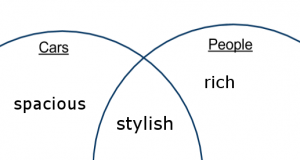
This is a fun way to practise comparative adjectives and superlatives using Venn diagrams.
Introducing and sorting adjectives
In the first part of this activity, adjectives are sorted into one of two areas on a Venn diagram. If they could apply to both areas they are placed into the overlapping middle area. See the examples below, or create one of your own using the blank template. If you’re creating your own version, make sure you choose a variety of adjectives with one syllable, more than one syllable, and words ending with Y.
Give each student a copy of the diagram. In pairs, students discuss where on the chart each adjective should be written; i.e. in the left or right circles, or in the middle if the adjective belongs in both categories. When everyone has finished, go through the adjectives and see if everyone agrees with their position. If students are unsure of the meaning of a word, they should ask you or each other, or look it up.
Comparisons
To practice comparisons, a dice is used to select two random items from one of the categories. Students must then make a valid comparison of the two items.
First, use some of the adjectives to review the grammar rules for making comparative adjectives. Then give students a die and a copy of the dice comparisons sheet (I usually just print it on the other side of the Venn diagram).
In their pairs, the first student rolls the die twice and must then compare the two items in the category using one of the previously learnt adjectives. For example, our list of items from the category Animals is elephant, monkey, lion, sheep, mouse, puppy. The first Student rolls a 1 and a 5 and makes a sentence like: an elephant is more intelligent than a mouse. Encourage them to respect the order the dice are thrown and not switch the items around to make the task easier.
If you don’t have any dice then Student A can simply give Student B two items from the list and Student A has to make a suitable comparison.
Superlatives
After students have practised making comparisons for five to ten minutes, review the grammar of forming superlatives and then have student-pairs compose superlative statements about the list items. For example, elephants are the biggest animal, monkeys are the most intelligent. Finally, go around the class collecting (and correcting) some of these superlative statements.
A DIY twist
Instead of giving the students pre-selected vocabulary to sort through, instead, give them a blank Venn diagram with only the two category headers written in. The students must now try to find adjectives or other related words for each circle, as well as some which apply to both categories.

Hello, thank you for your time and creativity. It is simple but yet usful and helps learners think, hopefully in the target language. 😀